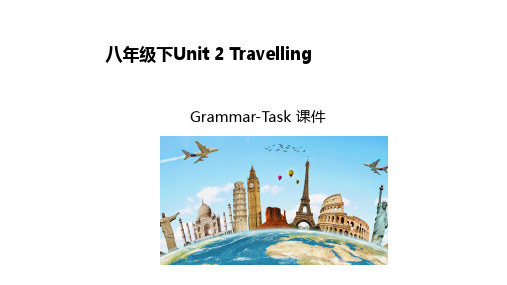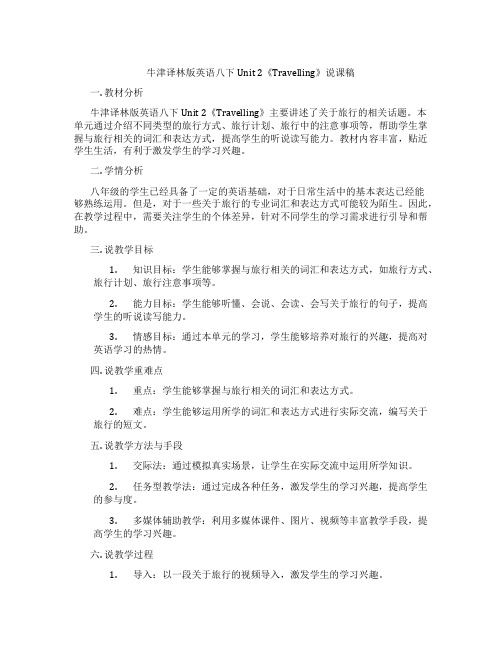牛津译林版八年级英语下册 Unit 2 Travelling教案
- 格式:doc
- 大小:168.01 KB
- 文档页数:13


Module 1 Unit 2 Travelling合肥英伦教育阚娜本课通过了解Kitty的香港之行,了解各个城市的著名旅游地点,以及扩展词汇谈论旅行中的见闻和活动,学习正确使用语法have/has been和have/has gone。
1.了解外国城市著名的旅游胜地和受欢迎的景点。
2.熟悉人们在不同景点从事的各种活动。
3.了解旅行时该携带哪些东西。
教学难点:Key words:waterfall, natural, light, beside, stranger, reply, rock, clear, rise rose-risen ground, below, bottom, canyon, top, disappear, distance, huge, myself, likely, face.Key Phrases: get out of; look over, on the edge of, at the bottom of .教学难点:学会正确使用have/has been和have/has gone。
学会正确区分短暂性动词和延续性动词。
学会短暂性动词在与for和since连用时的变化形式。
多媒体课件、录音机、教学素材Step1.Warm upFree-talk:1. Have you been to a place of interest? Where is it? What do you think of it?2. If you have enough money and time, where do you want to go? Why?Places of interest:Show some pictures about different places and Theme Park.Step2. ReadingRead quickly and answer questions:1. Who visited Disneyland?2. How did Kitty get there?3. How long did they stay in Disneyland?4 .Did they enjoy themselves?Fill in the blanks on the clue table.Retelling:Let the students use your language to retell the passage.Consolidation:Make an interview with your partner about your partner’s travelling. When you make this interview, please include these following questions.When did you go?Who did you go with?。

Unit 2 Travelling一、教学内容:Unit 2 TravellingGrammar二、教学目标:掌握Unit2的词法结构和用法:1. so…that /such…that/enough to/too…to…2. have/has been in, have/has been to, have/has gone to3. 延续性与短暂性动词经典讲解Grammar 1:so…that /such…that/enough to/too…to…解释:如此……以至于……so+ adj. /adv. +that从句或such+单/复数名词+that从句例:It’s so hot in summer that we can’t do without the air conditioner.夏天的天气热的我们少不了空调。
The teacher spoke so fast that I couldn’t understand what he was saying.老师讲得太快以致于我听不懂他在说什么。
He is such a genius that he doesn’t have to study much for exams.他是个天才,所以他考试都不用怎么念书。
They are such good basketball players that everybody wants to watch their games.他们个个都是很棒的篮球员,所以每个人都想去看他们打球。
表示:足以做某事enough to… 如: He is old enough to do it.意思是太……而不能too...to… 例: He is too young to go to school.中考so…that, too…to和enough to都是初中英语教材中的重要结构,在一定条件下它们可以相互转换,并经常成为中考考查的热点之一。


牛津译林版英语八下Unit 2《Travelling》说课稿一. 教材分析牛津译林版英语八下Unit 2《Travelling》主要讲述了关于旅行的相关话题。
本单元通过介绍不同类型的旅行方式、旅行计划、旅行中的注意事项等,帮助学生掌握与旅行相关的词汇和表达方式,提高学生的听说读写能力。
教材内容丰富,贴近学生生活,有利于激发学生的学习兴趣。
二. 学情分析八年级的学生已经具备了一定的英语基础,对于日常生活中的基本表达已经能够熟练运用。
但是,对于一些关于旅行的专业词汇和表达方式可能较为陌生。
因此,在教学过程中,需要关注学生的个体差异,针对不同学生的学习需求进行引导和帮助。
三. 说教学目标1.知识目标:学生能够掌握与旅行相关的词汇和表达方式,如旅行方式、旅行计划、旅行注意事项等。
2.能力目标:学生能够听懂、会说、会读、会写关于旅行的句子,提高学生的听说读写能力。
3.情感目标:通过本单元的学习,学生能够培养对旅行的兴趣,提高对英语学习的热情。
四. 说教学重难点1.重点:学生能够掌握与旅行相关的词汇和表达方式。
2.难点:学生能够运用所学的词汇和表达方式进行实际交流,编写关于旅行的短文。
五. 说教学方法与手段1.交际法:通过模拟真实场景,让学生在实际交流中运用所学知识。
2.任务型教学法:通过完成各种任务,激发学生的学习兴趣,提高学生的参与度。
3.多媒体辅助教学:利用多媒体课件、图片、视频等丰富教学手段,提高学生的学习兴趣。
六. 说教学过程1.导入:以一段关于旅行的视频导入,激发学生的学习兴趣。
2.新课呈现:通过展示图片、实物等,引入本节课的主题,引导学生学习相关词汇和表达方式。
3.课堂练习:设计不同类型的练习,让学生在实际交流中运用所学知识。
4.小组活动:学生分组进行讨论,分享各自的旅行经历,促进学生之间的交流。
5.课堂小结:对本节课所学内容进行总结,帮助学生巩固记忆。
6.课后作业:布置相关任务,让学生课后进行练习,巩固所学知识。

Unit2 Grammar教案Teaching aims:1.掌握“have/has been to” 和“have/has gone to”的用法。
2.理解短暂性动词和延续性动词的不同用法,以及它们之间的转换Teaching procedures:Step 1 ReviewFill in the blanks.1.The old man _______ (live) here since 1992.2._____ you _______(visit) our factory yet?3. I __________ (not see) you for a long time. You ___________ (change) a lot.4. I’m afraid I __________ (keep) you waiting for such a long time.5. He __________ (know) the city since he was very young.Step 2 Study Grammar A: Using have/has been 和have/has goneWe use have/has been to express the idea that someone went to a place and has already come back. It refers to an experience.e.g. Mille and Amy have been to South Hill. They want to go there again.Sandy has never been to South Hill. She wants to go with them.We use have/has gone to express the idea that someone went to a place but has not yet returned. e.g. Kitty and her family have gone to Hong Kong. They will come back next week.Suzy is not at home at the moment.She has gone to the bookshop.Step 3 Summaryhave/has been和have/has gone的区别Step 4 PracticeFinish the exercises on pages 26 & 27.A1 The Class 1, Grade 8 students are talking about their classmates and families. Help them complete the sentences with have/has been or have/has gone.1. Millie isn’t here. She _________ to the library.2. Peter and Simon ____ just _____ to the library. They borrowed some interesting books.3. My cousin __________ to Xi’an twice.4. My parents __________ to Xi’an and they’ll stay there for a week.5. Daniel won’t be w ith us at the party. He _________ to Shanghai.A2. Daniel and Millie are chatting. Complete their conversation. Use the correct forms of the verbs in brackets.Daniel: I haven’t seen Mr Wu for days. Where ____ he _____(go)?Millie: He __________ (go) to Tianjin to attend a meeting.Daniel: _____ you _____ (be) anywhere recently?Millie: Yes, I __________ to Hainan with my parents.Daniel: Oh, that’s great! ______ you ______ to Sanya?Millie: Sure, we _________(be) to the beach there. Look at these photos.Daniel: The beach is beautiful. I see Andy playing on the sand too.Millie: Yes, We went there with his family.Daniel: I see. By the way, shall we invite Andy to go for a picnic tomorrow?Millie: Andy isn’t here this weekend. He and his parents __________(go) to countryside. They’ll be back tomorrow afternoon.Step 5 Study Grammar B: Verbs with for and sinceWe use for when we talk about a period of time, and we use since when we talk about a time point in the past.e.g. Mr Dong has lived here for many years.Mr Dong has lived her since he was born.Some verbs, such as come, go, buy and leave, can be used in the present perfect sense, but they cannot be used with for or since in positive statements.Step 6 Summarysince和for的区别e.g. He has lived here for 16 years.他住在这里有十六年了。
Travelling课题8B Unit 2 Travelling Welcome to the unit课型新授授课日期月日第1课时教学目标1.To introduce well-known attractions in foreign cities and popular places of interest2.To activate general knowledge about the world .3.To identify activities which people do on holiday.教学重难点1. To learn some popular tourist attractions .2.To talk about traveling to some famous places.课前准备多媒体教学活动二次备课Check pre-exerciseStep1 Leading - inDiscussion:1. Each country has its places of interest.For example:(Show a picture of Great Wall)In China, there is Great Wall. At this time,write Great Wall and China on the Bb.2. Let the Ss tell more places of interestin foreign countries and write them on theBb.3. Ask them what people can do if they arein the famous places.Step2 Pre – task 11.Show the pictures of other five places ofinterest on the page 21. Ask Ss read thewords and do the exercise below.Lead them to read the names of places an dcountries.2. Show the picture of little Mermaid.T: It’s little Mermaid in D enmark . it’sfamous in the world.S1: Really ?.S2:That’s from the story by hans ChristianAndersen. .Step3 While - taskTask 1 .After reading the new words fluently, letSs match the three parts with lines ontheir exercise book.Task 2.Make dialogues. Show the picture of MountFuji.T: What’s this?Ss: It’s Mount Fuji in Japan.T: What can people do there?S1: They can climb hills/ take photos.Make dialogue about other five pictures inpairs.Step4Post - task1Practice the dialogue before the wholeclass.Step5 Pre - task 2T: Travelling is fun. Before your parentstake you out to go on a trip, you should packyour things. Write the phrases on the Bb.Teach them the meaning and thepronunciation.Step6 Whole task 2T: Now Eddie is going on a trip. Let’slook at the pictures one by one.Task 1.Show Picture 1. Act as Hobo. Ask: Hey,Eddie. Where are you going?Ss: I’m going on a trip. ( help themanswer.) Practise again.Task 2.Show Picture 2.T: You know, Eddie is going on a tripalone. But the trip must be fun. So Hoboasks: I have been there before. Can I joinyou ?Practise again.Task 3. Show Picture 3. Ask and answer withpresent continue tense.Ss: What are you doing, Hobo?T: I’m getting all my things .Task 4.Show Picture 4. Show the difference betweenP 2 and P4.Try to get their two thoughts. Present thedialogue between them.Step7 Homework:Preview the new words in Reading教后记8B Unit 2 Travelling教案课题8B Unit 2 Travelling Reading(1)课型新授授课日期月日第2课时教学目标1.To read a letter about a holiday in Hong Kong2.To expand vocabulary to talk about travelingRemember to find the five paints:when ,who,where , what, and how. Look at the questionsin part B1 and find the answers as quicklyas you can.The students finish t B1 after scanningpara1,22 Teach the students how to find the detailsand finish B2.Now we’re found out thatKitty went to Hong Kong Disneyland with herparents by underground .They spent a wholeday there and a fantastic time. But what didthey do there? Let’s read the rest of theletter and complete partB2. check theanswersStep4 ActivitiesT: Millie is still in Hainan and she hasn’treceived Kitty’s letter yet . One day,Millie called Kitty and asked Kitty abouther trip to Hong Kong Disneyland .Let’smake a conversat ion between Millie andKitty. It should have at least fivequestions.The students act it .Step5Homework1.Recite the new words2.Find out useful words and phrases inReading3.Do B3 and B4 on Page 25教后记课题8B Unit 2 Travelling Reading(2)课型新授授课日期第三课时教学目标1.To practise the main language points of the context2.To speak out the passage in their own words3.To understand and use the expressions in the text教学重难点2.To speak out the passage in their own words, following thestructure of the passages.课前准备多媒体教学活动二次备课Check pre-exerciseTranslate some phrases into English.1非常想念你 2 玩的开心3 快速行驶4 急忙去餐馆快速的吃饭5忍不住不停的拍照 6 买一对耳环Step1 RevisionT: Aak the following questions1) Where did Kitty go ?2)When did she go there ?3)Who did she go with ?4)How did she go there ?5)What did she do there ?6)How long did she spend there ?Step 2 Presentation1 Discussion in group of 4.Finish Kitty’s activity form with tenvocabulary that describe the time in the text2 Find the time vocabulary and fill in the placeand activity.Step 3 Explaining the language pointsI am going to explain the important words, phrasesand sentences in the passage.Step 4 Practising and Sum upAmy went to Kitty’s house for supper. Kittyshowed Amy her photo album. Amy was very excitedand asked a lot of questions. Finish Part B3 onpage 25, and then work in pairs to make the similarconversation. For stronger class, students canadd more questions.Ask the students to sum up the passage.Step 5当堂检测、及时反馈Kitty_____ (已经去) Hong Kong for two days. Sheand her parents had a great time there. They spentthe whole day in Disneyland.It is _____ (世界文明的主题公园) and it’s reallyfantastic. It is one big park, but it actually hasfour parks.They got to Disneyland from their hotel _____ (乘地铁). They took photos _____(在鲸鱼喷泉前) atthe entrance, then they went to Space Mountain.They took the roller coaster, it _____ (高速移动). In the afternoon, there was a parade ofDisney characters. The _____ (演出者) all woredifferent costumes and waved to people while theymarched across the park. The children _____ (鼓掌) and screamed with joy.教后记课题8B Unit 2 Travelling Grammar课型新授授课日期课时第4/5课时教学目标1.To recognize contexts for the use of the present perfect tense.2.To understand the verbs with ‘for’, ‘since’ or ‘ago’3.To consolidate the present perfect tense4.To understand the verbs with continuous time adverbials教学重难点1.‘have/has been’ and ‘have/has gone’2. Verbs with ‘for’, ‘since’ or ‘ago’课前准备多媒体教学活动二次备课Check pre-exerciseStep1 RevisionTranslate some sentences.1. 小名参军半年了。
牛津译林版英语八下Unit 2《Travelling》教学设计一. 教材分析牛津译林版英语八下Unit 2《Travelling》主要讨论了与旅行相关的话题,包括旅行计划、旅行方式、旅行地点等。
本单元通过引入一个关于两个朋友讨论旅行的对话,让学生掌握与旅行相关的词汇和表达方式,同时提高他们的听说能力和合作能力。
教材还包括了阅读理解、语法练习、写作任务和文化背景介绍等内容,旨在帮助学生全面了解旅行的话题,并提高他们的语言运用能力。
二. 学情分析学生在学习本单元前已经掌握了一定的英语基础知识,具备基本的听说读写能力。
然而,对于一些与旅行相关的特定词汇和表达方式,学生可能比较陌生。
此外,学生可能对不同国家的文化背景和旅行习惯有不同的了解程度。
因此,在教学过程中,教师需要关注学生的个体差异,合理安排教学内容,并采用适当的教学方法,以满足不同学生的学习需求。
三. 教学目标1.知识目标:学生能够掌握与旅行相关的词汇和表达方式,如旅行方式、旅行地点、旅行计划等。
2.技能目标:学生能够听说读写与旅行相关的句子,并能够运用所学知识进行简单的旅行计划的制定。
3.情感目标:通过学习本单元,学生能够培养对旅行的兴趣,提高合作能力和跨文化交际意识。
四. 教学重难点1.重点:与旅行相关的词汇和表达方式的掌握。
2.难点:正确运用所学知识进行旅行计划的制定和表达。
五. 教学方法1.交际法:通过模拟真实的旅行场景,让学生进行角色扮演和交流,提高他们的听说能力。
2.任务型教学法:通过完成旅行计划、讨论旅行经历等任务,培养学生的合作能力和解决问题的能力。
3.文化导入法:介绍不同国家的旅行习惯和文化背景,提高学生的跨文化交际意识。
六. 教学准备1.教材:牛津译林版英语八下Unit 2《Travelling》教材。
2.多媒体设备:电脑、投影仪、音响等。
3.教学材料:旅行相关的图片、地图、旅行计划模板等。
七. 教学过程1.导入(5分钟)–教师通过向学生展示一些旅行相关的图片,引起学生对旅行的兴趣。